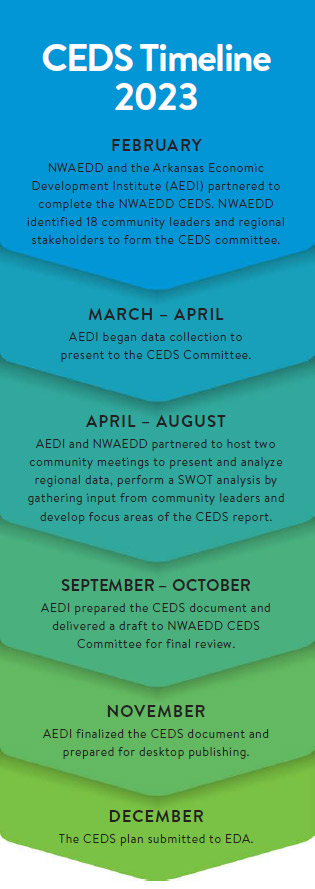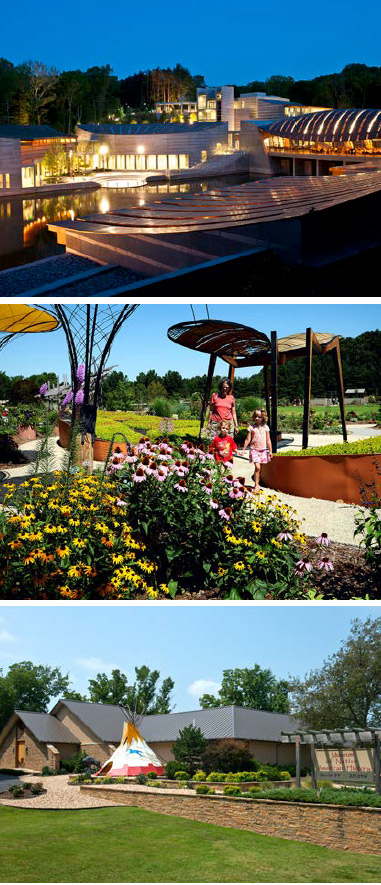Comprehensive Economic Development Strategy: 2024-2028
The Northwest Arkansas Economic Development District (NWAEDD) is an economic development district designated by the U.S. Economic Development Administration (EDA). As the region’s economic development district, it is responsible for developing a Comprehensive Economic Development Strategy (CEDS) that identifies economic and community development priorities for the District.
CEDS Introduction
A Comprehensive Economic Development Strategy or CEDS is a document designed to engage cooperation between the public and private sectors in the resiliency and health of the local economy. A CEDS analyzes the target area’s economic and social well-being and serves as a guide to establishing regional goals, strategies, investment priorities, and resources to benefit Northwest Arkansas. A CEDS seeks to maximize the target area’s unique advantages and minimize its disadvantages. Finally, a CEDS provides a benchmark for regional economic success.
The CEDS is a mandated document by the Economic Development Administration, (EDA) to define Economic Development Districts throughout the nation. The Northwest Arkansas Economic Development District (NWAEDD) and the CEDS Strategy Committee are to provide this document to reference economic conditions, development strategies, and projects throughout the 9-county district; this CEDS is not intended to be a “stand-alone” document. The CEDS is just one tool used in economic development.
The District’s CEDS is composed of four sections:
Summary background of the economic conditions of the region.
In-depth SWOT analysis of regional strengths, weaknesses, opportunities and threats
Action Plan outlining strategies drawn from the planning process that incorporates elements from other applicable regional plans
Evaluation framework to develop and monitor performance measures incorporated in the plan.

Summary Background
Northwest Arkansas is one of the fastest-growing regions in the state and is projected to experience a 7.3% increase in population over the next few years, putting the projected increase at more than 752,000 residents by 2027. The urban counties of Benton and Washington contain approximately 78% of the population of Northwest Arkansas, with the remaining rural counties having 22% of the area’s population.
Manufacturing, Healthcare & Social Assistance, and Retail Trade industries are the three dominant industries in the region, accounting for more than 113,000 jobs collectively. Over the next five years, the Arts, Entertainment, and Recreation industry is projected to experience a 2.6% increase, the largest of any industry in the area. This industry was heavily impacted by the COVID-19 pandemic and thus is experiencing a rebound in growth.
Environment and Outdoor Recreation
The NWAEDD region is vast and encompasses the picturesque Ozark Mountains and several state parks. The eastern portion of Northwest Arkansas is largely rural, with many small towns and communities scattered throughout. Residents can enjoy the peacefulness and tranquility of rural living, with open spaces and a closer connection to nature.
The western part of the region includes the Fayetteville-Springdale-Rogers metro area, which is the second-largest metro area in the state.
The area has abundant natural resources including the Bull Shoals and Norfork Lakes which are two of the largest in the state. Additionally, numerous streams, rivers, and lakes provide water recreation opportunities. Outdoor enthusiasts can enjoy mountain biking, camping, fishing, and rock climbing.
Culture
Urban centers, villages, and rural communities with a sense of place are a common feature of communities within Northwest Arkansas. Residents often have strong ties to their communities, participating in local events, festivals, and community organizations. Artists and creative workers in the area have a large and growing impact on the regional and state economies. The cultural and artistic opportunities that abound attract residents, and visitors and increase tourism and tax collection revenue. The Crystal Bridges Museum, Museum of Native American History, botanical gardens, and film festivals are some of the many offerings in the region.
Demographic and Economic Data
The NWAEDD region has a population of over 700,00 people and has grown by 21% over the last 11 years. The area is projected to experience an increase of 7.3% over the next few years.

